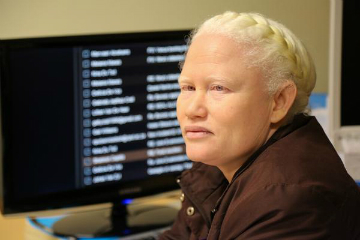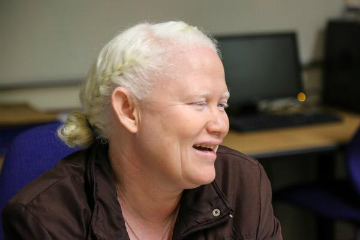Raising awareness about Albinism
 Albinism is a rare genetic condition that reduces the amount of melanin pigment formed in the skin, hair or eyes and occurs in all racial and ethnic groups throughout the world.
Albinism is a rare genetic condition that reduces the amount of melanin pigment formed in the skin, hair or eyes and occurs in all racial and ethnic groups throughout the world.
People with albinism face multiple forms of discrimination because it's still profoundly misunderstood, socially and medically.
The United Nations Human Rights Council adopted a resolution in 2013 calling for the prevention of attacks and discrimination against persons with albinism.
International Albinism Awareness Day (IAAD) is commemorated annually on 13 June and in South Africa we observe National Albinism Awareness Month in September. The aim of both these campaigns is to raise awareness about people living with albinism.
Put the person first
The international non-governmental organisation, NOAH, notes that "although there are many people with albinism who are at peace with the term albino, when dealing with any condition, it's is best to put the person first. For instance, say, "a person with albinism" rather than "an albino" or "an albino person." The rationale for this person-centered language is to do just that: put the person ahead of the condition."
Types of albinism
While most people with albinism have very light skin and hair, levels of pigmentation can vary depending on one’s type of albinism.
There are 2 main types of albinism:
- Oculocutaneous albinism (OCA) – the most common type that affects the skin, hair and eyes.
- Ocular albinism (OA) – less common, involves only the eyes, while skin and hair may appear similar or slightly lighter than that of other family members.
Symptoms of albinism
Eyes:
- light brown to pale blue in colour,
- sensitivity to the sun,
- fast involuntary back and forth movement of the eyes, which improves with age,
- squinting, and
- visual impairment and low vision.
Skin:
- very light and pale in colour,
- freckling or pigmented patches might develop on sun–exposed areas, and
- very sensitive to the sun and can burn easily.
Hair:
- hair colour ranges from white, yellow, light brown to reddish, and
- eye lashes and brows appear whitish.
Myths and facts
The myths associated with albinism can be misleading and have a negative influence on the lives of people with the condition, as well as their families. Some of these myths include:
- Myth: Albinism is contagious.
- Fact: Albinism is a genetic condition passed on by both parents. It can’t be caught and isn’t contagious.
- Myth: Albinism is a curse or a punishment.
- Fact: Albinism is a genetic condition that results in a lack or total absence of melanin (pigmentation) in the body. It’s not a curse or a punishment for past wrongs.
- Myth: People living with albinism are less intelligent.
- Fact: Albinism merely affects the level of melanin in the body, and the lack of melanin present in the development of the eyes, most people with albinism suffer from significant vision impairment which can affect learning and education outcomes.
- Myth: Albinism only affects appearance.
- Fact: Melanin is integral to developing skin, hair and eye colour, however it’s also vital for the development of healthy vision.
- Myth: People living with albinism can’t go outside during the day.
- Fact: People living with albinism can go outside at any time but need to take extra precautions when out in the sun. Protective clothing, sunscreen and a hat are required all year round to minimise the risk of skin damage from the sun.
 Living with albinism
Living with albinism
Delicia De Vos, an Administrator of Disability Support at the Disability Unit at the Cape Peninsula University of Technology (CPUT), is a person living with albinism. As part of her job Delicia is responsible for assisting the students with disabilities who study at CPUT with their applications, registrations, bursary applications and other day-to-day support. She's currently also studying towards a post-graduate qualification in Disabilities Studies at the University of Cape Town.
Delicia was born in Namibia and attended the Athlone School for the Blind from the age of 5. After she matriculated, Delicia says, the most difficult thing she was confronted with was people’s negative perceptions about albinism and those living with it. She also recalls experiencing social discrimination at her first job saying that the people’s attitudes, the lack of knowledge, and being afraid of things different to the norm, are the biggest problems fuelling stigmas and misperception.
"Albinism doesn’t affect my life because it doesn’t limit me from doing things, however, it does affect my life in a way because of people’s attitude", says Delicia. Learning to accept yourself and your condition is what, helped her move on from the criticism and start to positively change her own life, as well as the lives of other people living with albinism.
Changing attitudes and making our communities tolerant and Better Together
"As a society in general, we get so used to the idea that when someone doesn't fit neatly into the boxes we have of what a person should look like, then we judge them." Delicia says. "Change starts with you as a person living with albinism. We need to spread the word and help educate people about albinism", says Delicia.
Her advice to young people living with albinism is to accept themselves for who they are, go for their goals and not allow people to break their spirits or take away their life experience from them. We need to work hard to change the attitudes – not only towards people living with albinism, but towards all persons that may seem different from us.
She hopes that by learning a little more about the condition will help other people to better understand it and raise awareness that will lead to greater acceptance by our communities.
Reach out and learn some more
If you want to know more about albinism, you can visit:


